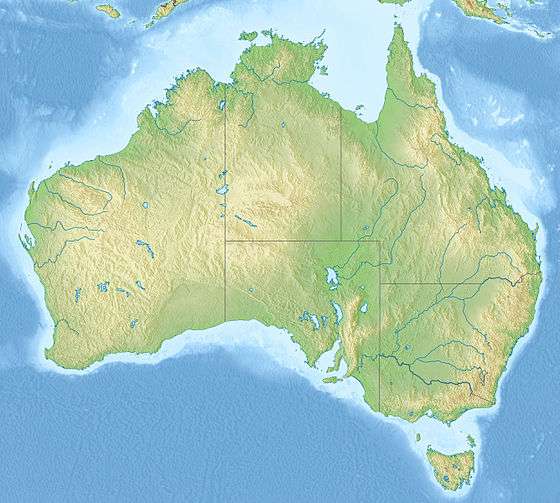Wallumbilla Formation
The Wallumbilla Formation is an Aptian geologic formation found in Australia. Plesiosaur remains are among the fossils that have been recovered from its strata.
| Wallumbilla Formation Stratigraphic range: Aptian ~125–113 Ma | |
|---|---|
| Type | Geological formation |
| Unit of | Rolling Downs Group |
| Sub-units | Trimble Member, Ranmoor Member, Jones Valley Member, Doncaster Member, Coreena Member |
| Underlies | Toolebuc & Griman Creek Formations |
| Overlies | Cadna-Owie & Bungil Formations |
| Thickness | 600 m (2,000 ft) |
| Lithology | |
| Primary | Mudstone, siltstone |
| Other | Sandstone, limestone |
| Location | |
| Coordinates | 20.8°S 143.7°E |
| Approximate paleocoordinates | 60.2°S 124.4°E |
| Region | |
| Country | |
| Extent | Eromanga Basin |
 Wallumbilla Formation (Australia) | |
Description
The formation is present in the Northern Territory, Queensland, South Australia, and New South Wales. It is a sedimentary unit, principally made up of mudstone and siltstone, with calcareous concretions. Its maximum thickness is 600 metres. Its age is somewhere from Aptian to Albian, that is between 125 and 101 Mya. The formation is part of the Wilgunya Sibgroup, which in turn is part of the Rolling Downs Group of the Eromanga and Surat Basins. The named beds are the Coreena, Doncaster, Jones Vally, Ranmoor, and Trimble Members.[1]
Fossil content
| Paleofauna of the Wallumbilla Formation | ||||||
|---|---|---|---|---|---|---|
| Genus | Species | Location | Stratigraphic position | Abundance | Notes | Images |
| Notopala Cotton, 1935 | † Notopala albascopularis (Etheridge, 1902) | White Cliffs, New South Wales | The oldest freshwater snail in Australia.[2] | |||
| Kronosaurus | Indeterminate | White Cliffs | A pliosaur, also found in Queensland's Toolebuc Formation and Colombia's Paja Formation | |||
| Theropoda | Indeterminate | |||||
| Platypterygius | Indeterminate | An ichthyosaur | ||||
gollark: Do you have a not caring about licensing license?
gollark: You can't do the impossible. Only we have the appropriate licensing.
gollark: It's not safe, actually.
gollark: Well, improve it.
gollark: Recharge the internal timekeeping battery.
References
- Geoscience Australia: Stratigraphic Units Database
- Kear B. P., Hamilton-Bruce R. J., Smith B. J. & Gowlett-Holmes K. L. (2003). "Reassessment of Australia's oldest freshwater snail, Viviparus (?) albascopularis Etheridge, 1902 (Mollusca : Gastropoda : Viviparidae), from the Lower Cretaceous (Aptian, Wallumbilla Formation) of White Cliffs, New South Wales". Molluscan Research 23(2): 149-158. doi:10.1071/MR03003, PDF.
Further reading
- E. F. Riek. 1954. A second specimen of the dragon-fly Aeschnidiopsis flindersiensis (Woodward) from the Queensland Cretaceous. The Proceedings of the Linnean Society of New South Wales 79:61-62
This article is issued from Wikipedia. The text is licensed under Creative Commons - Attribution - Sharealike. Additional terms may apply for the media files.